![]()
![]()
![]()
Use LEFT and RIGHT arrow keys to navigate between flashcards;
Use UP and DOWN arrow keys to flip the card;
H to show hint;
A reads text to speech;
55 Cards in this Set
- Front
- Back
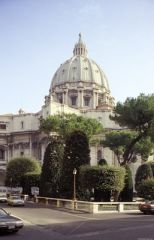
|
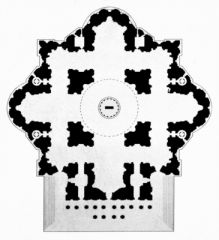
Michelangelo, plan and dome, St. Peter’s. 1546-1564
Michelangelo's background in sculpture is seen in his design for the remodeling of St. Peter's. The colossal pilasters aren't very classical in origin, but they work to knit together the huge facade of the basilica. They work to emphasize the compact body of the structure, setting off the dome more dramatically. The double-shell design of the dome is influenced by Brunnelleschi's dome of the Florence Cathedral, but Michelangelo forgoes Brunnelleschi's smoothed surface for a sculptured shape with columns to link it visibly to the rest of the building. For the interior, Michelangelo continued to seek compactness and organic unity. He simplified Bramante's original plan, which was complex and fussy in nature, into a more solidified and distinct cross and square, making columns sufficient enough to support the size of the dome. |
|
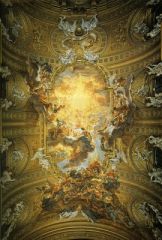
|
Giovanni Battista Gaulli under the guidance of Bernini, Triumph of the Name of Jesus, ceiling fresco with stucco figures. 1672-79, Il Gesù, Rome
The sharp contrast between Renaissance order and definition and Baroque drama and breaking of rules is fully alive in this ceiling fresco. The fresco is spilling out of the borders of the frame, giving the illusion that the heavens are breaking open and spilling out into the church. It immediately creates drama, which is further heightened by the painted shadow to add to the realistic experience of heaven in the church. The ceiling was a strong focus of the Baroque period, especially in an illusionistic fashion as seen here. |
|
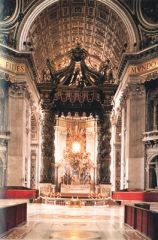
|
Gianlorenzo Bernini, Baldacchino, gilt bronze. 1624-33, crossing, St. Peter’s, Vatican, Rome
Solomonic columns (twisted), referencing early Christian basilicas of ancient Rome and King Solomon's temple, reasserting the majesty and magnigificany of the Catholic Church during Protestant Reformation. The grand dome, the baldacchino, St. Peter's remains are all in one linear spot evoke wonder, drama, and a heightened spiritual experience to the visitor. |
|
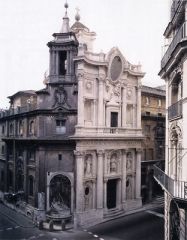
|
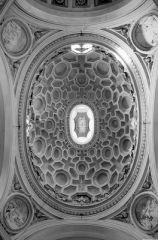
Francesco Borromini, San Carlo alle Quattro Fontane, 1638-1667. Façade and dome, Rome
The facade evokes many elements characteristic of baroque architecture: the concave and complex forms make it full of swelling movement and heightened drama. The tiny space it occupies is maximized through the drama of the facade and demands attention. The interior continues to break all ideals of Renaissance architecture in typical Baroque fashion. Forgoing strict rules of even shapes and proportion, Borromini uses a variety of unorthodox geometric shapes like ovals. Also in stark contrast to earlier Catholic churches, Borromini forgoes color: the drama of the interior is completely dependent on the light interacting with the architecture. Strategically placed windows, hundreds of crevices and moldings create a thick air of drama within the small space. |
|
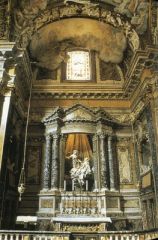
|
Bernini, St. Teresa in Ecstasy, marble. 1645-52, Cornaro Chapel, S.M. della Vittoria, Rome
One of the works created during his out of favor period with the pope, Bernini's St. Teresa in Ecstasy is a multimedia extravaganza installation piece. The niche is not static, instead the columns are at an angle with the wall as if they're breaking away. It adds to the high drama of the event that that's depicted: St. Teresa's vision of God. To add to the drama of the moment, Bernini takes a heightened sexual approach in Teresa's facial expression and the form of her body. It would have demanded attention of the viewer and draw a full body experience to a religious story. This intention to engage people in a visceral, sensual way was characteristic of the renewed thrust of Catholicism of the day. |
|
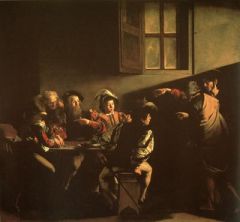
|
Caravaggio, The Calling of St. Matthew, oil/canvas. ca. 1599-1600, Contarelli Chapel, San Luigi dei Francesi,
Rome The Calling of St. Matthew embodies Caravaggio's characteristic painting style that influenced so many artists after him. The shallow space of the picture (ends right at the wall behind the figures), reduced color palette, use of everyday people as models, and minimal detail are characteristic of Caravaggio. Caravaggio takes into account the placement of the canvas through the use of illusionistic light (tenebrism) that mimics where the real light falls on the image in its place and the foreshortened line of Matthew's finger pointing to himself as the image is viewed from the side: both of these add an increased sense naturalism and drama to the scene. |
|
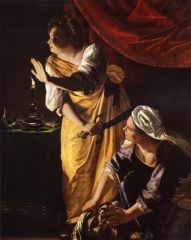
|
Artemisia Gentileschi, Judith and Maidservant with the Head of Holofernes, oil/canvas. ca. 1625
An official Caravaggisti, Gentileschi is especially noteworthy for being a woman in a world previously dominated by men. Like Caravaggio, Gentileschi uses strong diagonals and a dramatic sense of light and dark chiaroscuro to invoke drama. In a style uniquely her own, she adds an internal light source in many of her works, seen here by the candle. Her color palette is also more varied than Caravaggio's, seen in the use of reds, purples, blues, and yellows. |
|

|
Diego Velázquez, Water Carrier of Seville, oil/canvas. ca. 1619
This early work of Velazquez shows a faint Caravaggio influence through the rhythmic tenebrism, the shallow background, and the use of everyday, non idealized models. Velazquez had a keen understanding of optics: though his fine attention to detail (seen in the water droplets on the vase) and his painterly loose brush stroke in the water glass, we get an illusionistic representation of the moment in time. |
|
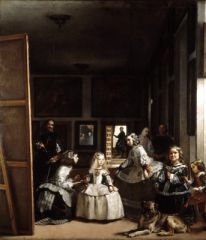
|
Velázquez, Las Meninas (The Maids of Honor), oil/canvas. 1656
Velazquez's Titian influence that he gained as a courtier is visible in Les Meninas. His style changed from a designo to a colorito, loosening his brushstroke even more dramatically than Titian. The brooch on the little girl's dress exemplifies his evolution into an artist with a sophisticated understanding of retinal impression and illusionism. The sparse use of paint (see the exposed canvas on her neck), also sets Velazquez apart from Titian. He assets his virtuosity as a painter though his limited palette, optical style, wide range of tonality, the vibration of color, and expressionistic painting surface. |
|

|
Caravaggio, Conversion of St. Paul
Caravaggio's typical vivid tenebrism is seen in Conversion of St. Paul. The figures seem almost too large for the frame, and they overwhelm the viewer as their size is only partially revealed by the light. The use of light and selective highlighting gives the figures a startling presence and theatricality typical of the Baroque. |
|
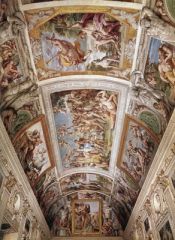
|
Annibale Carracci, Loves of the Gods
Trompe l'oeil: talk in general one: baroque art one of the things in general is the ceiling quadric riportati: from Raphael, although the painting is done as a fresco, use of "frames" to : painting an image onto a framed canvas and placing it onto the ceiling, not taking into account viewship like the Sistine Chapel. |
|

|
Guercino, Aurora
Guercino takes into account viewership in this Baroque-style ceiling painting. The legs of the horses are foreshortened, and their bellies are hanging towards the ground, giving the illusionistic impression that the horses are galloping over the viewer's head. Typical of the Baroque period, quadratura is used to further the illusionistic sense of the ceiling. The drama and life-like qualities are enhanced by the Titan-influenced bright color and intense light. |
|

|
Borromini, Sant’Ivo
Hexagonal dome, convex and complex curves. Irregularity of forms is a departure of Classical Renaissance structures: drama of baroque Six sided form resembled the Barborini bee: reasserting the legitimacy of the papal family. |
|
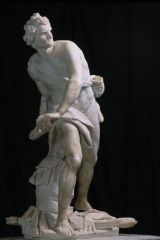
|
Bernini, David
Bernini's David shows a distinct feature of Baroque sculpture: an active relationship with the surrounding space. The presence of Goliath is uniquely implied here. Like other Baroque sculpture, it is meant to be seen from one primary point of view. The "moment of action" is presented, unlike the contemplation to kill or the aftermath of slaying Goliath of earlier Davids. The heightened vitality and energy, as seen by his intense expression and strong movement, heighten the drama of the sculpture, capturing both the motion and emotion of the story. |
|

|
Velázquez, Juan de Pareja
Pareja was a servant and assistant who accompanied Velazquez to Rome, and when waiting to paint the pope he painted Pareja. Velazquez was always trying to heighten the intensity of the naturalism. The torn cloak and beautiful lace collar displayed his tremendous technicality, elevated him beyond what others were doing. He was painting life as it was, in a non-idealized form. |
|
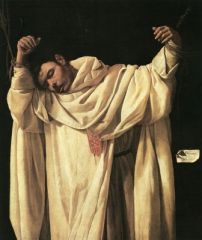
|
Francisco de Zurbarán, St. Serapion
The influence of Caravaggio is seen with the use of a limited palette and the immediacy of the figures in the foreground as well as the intensity of the naturalism. This is a fusion of pictorial and spiritual purity meant to invoke the viewer to contemplate the spiritual devotion because of the stark purity of the image rather than displaying the suffering or torturing of St. Serapion. It is a calm depiction of what was a violent death and the focus is on the figure, by contrasting the dark background against the bright whites of the clothing. |
|

|
Rembrandt van Rijn, Night Watch (The Company of Captain Frans Banning Cocq), oil/canvas. 1642
Follows the Netherland tradition of making group portraits, there is a strong use of light and darkness as well as diagonals and lines showing you where to look, such as the swords and sticks and the flag. The diagonals add a dramatic element as well as the fact that the light isn't naturalistic, it is set like a stage. There are certain areas of detail and certain smoky areas; Rembrandt treated the surface of the canvas differently, he uses very thick paint (imposto) and uses the other end of the brush to dig into the imposto to create patterns, almost like a relief. The Baroque is very dramatic and Rembrandt uses the sword and the hand of the captain to puncture the plane, which never occurs in Renaissance. Rembrandt is unique in his thickness and the amount of paint he uses as well as that he is not interested in illusionism. |
|

|
Rembrandt, The Hundred Guilder Print, etching and drypoint. ca. 1647
Rembrandt is using light in an iconographic or symbolic fashion rather than in a naturalistic way; the light seems to come from the figures themselves rather than an external light source. This extinctive use of light shows the religious or symbolic significance. The technique of using dry point in combination with etching highlighted the deep lines and gave them a fuzzy quality which increased the theatricality and drama of the image. |
|

|
Jacob van Ruisdael, Bleaching Grounds Near Haarlem, oil/canvas. ca. 1670
Landscapes become very important in the Baroque especially Dutch paintings, the sky is very important, as is here the sky takes up most of the painting. The landscape is more naturalistic and flat and there is a feel for the overpowering sense of nature, especially because the sky is so large and gives the land a smallness. The light could be naturalistic but more likely the artist is highlighting the fields because they are bleaching cloth which is how the Dutch made their money in trade; this is a painting highlighting the industry that goes along with this new country, a celebration of the land and would've been immediately recognized by a Dutch contemporary. |
|
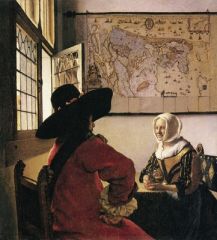
|
Jan Vermeer, Officer and Laughing Girl, oil/canvas. ca. 1657
Vermeer offers a little slice of life, it's a genre painting. He is extremely interested in light and was exceptionally talented at showing the way the light actually works and uses highly naturalistic art, as seen in the window and the detail he takes to portray exactly how the light would fall. Vermeer also rediscovers scientific perspective from the Renaissance and using a vanishing point and probably a perspective string grid. His is unique though because his vanishing point is the space in between the two figures and not on the figures themselves. This is also typical Northern because of the attention to detail as seen in the window and map, which was part of the Northern industry at the time (map making and travel). |
|
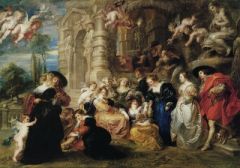
|
Peter Paul Rubens, The Garden of Love
Rubens was truly an international artist diplomat, and this is different from his other earlier works. It reflects the changes in his life as he got married. It's focus is on his domestic life, a tribute to life's pleasures. The cupids, couples, statue of Venus, and soft lines add a sense of sensuality to the painting that influenced Rococo works to come soon after. |
|
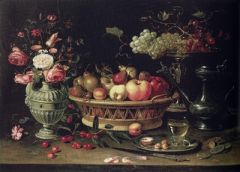
|
Clara Peeters, Still Life with Fruit and Flowers
Peeters was one of the earliest still-life painters, a pioneer of the genre, even more notably a woman. Guilds began to admit women during this time period when the number of patrons were also expanding, due to the increasing wealth upper middle class and the Protestant Reformation. The attention to detail is traditional of Flemish painting, seen in the wide variety of flowers and fruits represented. The use of allegorical and symbolical elements is also typical of the area, with the knife symbolizing her own wedding and the fidelity associated with the union of marriage. The fruits and flowers represent the bounty and hopefulness of the event. |
|
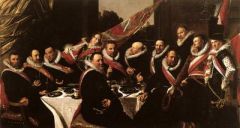
|
Frans Hals, Banquet of the Officers of the St. George Civic Guard
The loose brush stroke, painterly quality, and sense of spontaneity enhance the intense naturalism of the officers and their gestures. Group portraiture used to be very formal and this is not; it is relaxed, casual, has a sense of lightness, some of their mouths are open. There is a greater degree of informality by using the wetness of the paint and applying wet paint onto oil paint that hasn't yet dried, there are different widths to the brush stroke and a variety to it. There is also a contrast between the black and white that is accented with sharp reds. This combines the genre painting with the portraiture painting. |
|
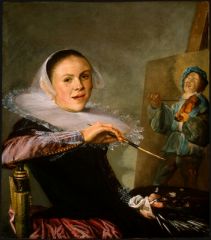
|
Judith Leyster, Self-Portrait
This was most likely Leyster's presentation piece to the artist guild in Haarlem. As a woman entering this new professional status and position, she uses the canvas to sell herself as an artist. She shows both a portrait and genre painting to advertise her diverse talents. Her technical skill is revealed as she yields numerous brushes and a palette in her studio, open-mouthed, casually conversing with the viewer. Many women artists of the time showed themselves painting. |
|
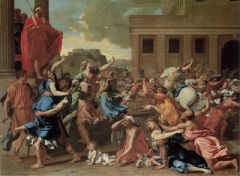
|
Nicolas Poussin, The Abduction of the Sabine Women, oil/canvas. 1633-34
Poussin's travels to Rome certainly influenced his style of baroque classicism. The rhythmic pattern of composition between the men and women is carefully staged, the multiple vanishing points and perspectives give the frozen moment movement. This is possible through Poussin's tendency to carefully plan his works, often using dioramas to model the scenes. Abduction of the Sabine Women is a history painting, which was of the highest importance in the ranking system of artwork at the time. Poussin's erudition is displayed through the visible allusion to Roman sarcophagi in the crowded, frozen composition, the reference to the Belvedere torso of the papal collection, and Giambologna's Rape of the Sabine Woman. |
|

|
Claude Lorrain, Pastoral Landscape, oil/copper. ca. 1648
Lorrain was famous for his landscapes because he showed an idealized Roman country side with a sense of nostalgia and longing or a past that never existed, not very realistic. Tiny because it was painted on copper but that gave it the sense of smoothness to the atmosphere to reflect the transparency of light and avoid the cracking you get from painting on canvas with oil. The light is not very deliberate is is more misty and idealized and he was very popular and people wanted to paint like him. |
|

|
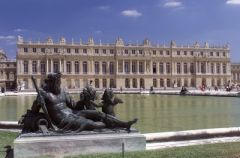
Louis Le-Vau, Jules Hardouin-Mansart, André Le Nôtre, Palace and Gardens at Versailles. Late 17th century
Both the gardens and the palace evoke the ideas of drama and theatre that were characteristic of the French Baroque period. The landscape was as conceptually magnificent as the palace itself; Le Notre took into consideration viewership from within the palace as he designed the landscape. The park follows its Grand Axis from east to west, intended to imply the course of the sun as it rises in the east over the king (the Sun King) in the palace and sets in the west at the farthest point of the gardens. The extravagant details of the palace and gardens were meant to reinforce the majesty of both Louis XIV’s reign and France. |
|

|
Christopher Wren, St. Paul’s Cathedral, London 1675-1710
infusion of italian and French baroque architecture: strong understanding of geometry, dome inspired by st. peters, double columns inspired by the Louvre, structural support of all the columns, Borromini influence in the double facade (stacking) and the lantern. Wren was the baroque counterpart of the Renaissance artist-scientist. His knowledge from his studies was visible in his design of his works. |
|
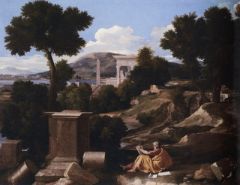
|
Poussin, Landscape with St. John on Patmos
With this work, Poussin is said to have created the ideal landscape. His thoughtful planning is seen in the ordered balance of light and dark. Poussin is unique in his degree of archeological architectural specificity. As an intellectual, he wanted to raise painting to a level of a liberal art, so he used classical forms to show his archeological knowledge. The ruins in the foreground and background suggest both the actual site and the concept of antiquity upon which early Christianity was founded. As in Poussin’s typical landscape style, the figure of John plays a minor role. |
|

|
Hyacinthe Rigaud, Portrait of Louis XIV
This was monumental and conveyed the power, drama, and splendor of Louis. He is shown life size and full length which follows the nature of royal portraiture to display symbols of royalty and wealth such as the high heels and luscious canopy and velvet and golden drapery. The artist created this illusion that he is tall, which Louis wasn't, to evoke authority and also showed off his legs which Louis was very proud of. Rigaud also intentionally wanted this to resemble Van Dyck's portrait of Charles I by showing the royalty at full length and make him appear stately and authoritative. |
|

|
Hall of Mirrors, Versailles
The Hall of Mirrors is located at the top end of the palace, on a space adjacent to where the gardens start. A liminal space, the mirrors are placed in such a way opposite the windows so that they reflect the magnificent gardens outside, a hinge between both worlds. The light that is brought in by the windows and mirrors is a further reflection on King Louis as the Sun King. |
|

|
Inigo Jones, Banqueting House, London
Jones was an affirmed disciple in Palladio, introduced Palladio's Renaissance architecture to England. Seen by the proportionality , the Ionic and composite orders of the pilasters, alternating segmental and triangular pediments over the first floor windows. |
|
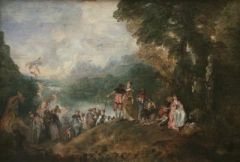
|
Jean-Antoine Watteau, Pilgrimage to Cythera, oil/canvas. 1717
Unlike typical Rococo this was very large and remarkable and impressive, so much so the Academy for Art gave it its own category--fete galante. The landscape takes on the primary role but there are a series of people and emotions, sadness, regret, nostalgia, such as has not been seen prior. There is a lightheartedness to the island and a series of lovers with shows us the pilgrimage to the land of Aphrodite which gives it a historical and allegorical aspect. The overall tones are more amorous though and it was meant to be the entrance to a salon in Paris, meant for the leisurely class, has courtly overtones. It is more colorito than disegno and is similar to a Titian/Giorgione landscape, looks Venetian. |
|

|
Jean-Honoré Fragonard, The Swing, oil/canvas. 1767
Very much the epitome of Rococo, beautifully painted in a frivolous and airy way. Fragonard studied the classics and couldn't care less he learned to pain in his own way. Like a Venetian painting there is a palpable sense of atmosphere and similar tonality with roses and blues which were very Rococo. This was a small intimate painting with lots of details such as roses and cupid and referencing love. The figure is beautifully composed in the spotlight and it's a silly story being told. |
|

|
Jean-Siméon Chardin, Back from the Market
softness of the brushwork shows the beauty of everyday life. Slice of life image: his composition of space suggests Vermeer, but different from the sharpness and precision of Vermeer Chardin has a softer quality that gives more naturalism and texture. The loaves of bread are an area we can clearly see this. |
|
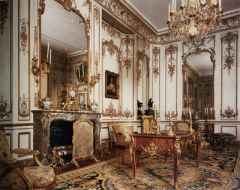
|
Nicolas Pineau, Hôtel de Varengeville
The rise of the salon was characteristic of the Rococo period and of aristocracy moving back into Paris. The white walls encrusted with guilded ornamentation (characteristic of the Rococo) and elaborately carved gilded furniture give a strong sense of design and materials. There’s no clear distinction between decoration and function in the rich fireplace and opulent chandelier, lending to the overall completely decorated scheme and the Rococo element of fantasy |
|
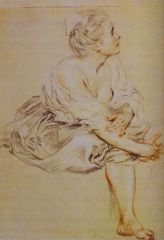
|
Watteau, Seated Young Woman, Trois crayon drawing
A master draftsman, Watteau was able to combine both color and line, excelling in the trois crayons technique. The three colors are here used in best effect: the red defines her body – legs, hands, parts of the face – it suggest a vivacious quality when contrasted against the black and white of her clothing, eyebrows, and upswept hair. Zig-zag lines in the folds of her dress invoke a light, shimmering quality to the fabric. He imported these techniques into his paintings, notably the shimmering of the silk gowns in Pilgrimage to Cythera. |
|

|
Rosalba Carriera, Charles Sackville, Second Duke of Dorset
During the 18th century, artists began to use pastel as a medium for finished works (rather than primary sketches of the past). Pastel’s ability to suggest line and color simultaneously led to their popularity as a medium, and Carriera is noted as one of the greatest pastel portraitists. She achieved an ability to interpret the psychological intensity of her sitters through the use of pastels. The intimacy of her technique, combined with the indistinct, even hazy quality of her images, suggests a tantalizingly allusive sensuality, as seen in the Second Duke of Dorset. |
|

|
William Hogarth, He Revels (The Orgy)/The Rake’s Progress, engraving
The painting has a sense of morality and ethics particularly related to the middle class values and virtues and a desire to return to simpler times. There is a satirical quality to it; the painting had a large audience which was the emerging middle class in England. Stylistically it had Dutch source with the focus on detail, morality, and an emphasis on the narrative. There is also a use of light. |
|
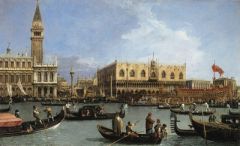
|
Canaletto, Bucintoro on the Molo
Artist known for view paintings (bedunte? dk what that word was he used in review) There is a tremendous amount of topographical accuracy because Canaletto's prints and paintings were popular as souvenirs especially with the British students who went to Italy to study. This is a very specific representation of a Venetian city and to create these he may have uses a camera obscura. His training as someone who made stage sets for operas may account of the theatricality and lightness of his compositions. |
|
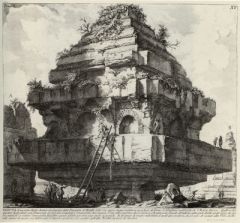
|
Giovanni Battista Piranesi, Tomb of the Metalli, Plate XV from Antichità Romane III, etching. ca. 1756
Both Neoclassic and Romantic elements can be found here. The superiority of Greece and Rome references antiquity but the reference to the sublime points to the Romantic elements of the etching. This is the era when the study of archaeology was born and people knew about antiquity but didn't have cities to look at. People are traveling to Rome and studying and this would've been a print they would collect while traveling; part of a series of prints of the city of Rome commissioned to document architecture and it is very detailed with lots of cross hatching. The people are dwarfed and it's not 100% accurate but wanted to show how small they are compared to the grand Romans that even their ancient ruins are more grand. |
|
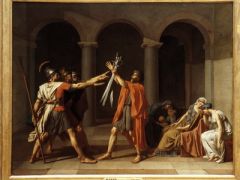
|
Jacques-Louis David, Oath of the Horatii, oil/canvas. 1784
Huge painting, meant to make an impact and be shown at the salon. This would become a hallmark for revolution with the father in the middle and the three brothers pledging to defend the Horatii. The message is family is loyal, importance of ethics and morality and reason to use the classical style; this becomes associate with the French revolution after the fact. There is a pattern of threes and there are sharp contours and archaeological accuracy as if it's taking lace in ancient Rome. Added style of art called Doric associated with the Roman republic. There is a muted palette and shallow space and dramatic use of light which shows he was rediscovering Cravaggio (calling of St. Matthew) but his highly idealized figures reference antiquity. |
|

|
Benjamin West, The Death of General Wolfe
West is responsible for popularizing contemporary history painting. The art world was shocked when he announced this painting, but the public applauded him. It made the audience feel as if they were witnessing a great national hero at the moment he sacrificed his life for his country. Despite its representation of a modern scene, West aggrandized and classicized his figures and the event, creating a modern Classical scene. The Lamentation is echoed in the composition and figure are noble and controlled in Classical decorum. Figures strike contrapposto poses and stand in Classical profile. |
|

|
Lord Burlington and William Kent, Chiswick House
Lord Burlington was heavily influence by Palladio and designed this house with William Kent that would become very famous Palladian-revival house. Based on Palladio's villa Rotunda, which Lord Burlington had studied and toured. The house is known for its simplicity and logic with smooth walls, a Greek temple portico protruding from the walls, and it is shaped like a cube. There is a clear sense of geometry that is easy to read and it is the conveyance of order and logic in a noble and moral way to resemble a republican government. Burlington believed art was to deal with morals and aesthetics rather than function. |
|
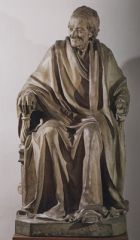
|
Jean-Antoine Houdon, Voltaire Seated
Houdon exemplifies Enlightenment empiricism, incorporating realism into a facade of Classicism. He had an ability to capture both the look and essential character of his sitter. Classical elements of the roman toga, headband, and the ancient chair, combined with the realism in the intensity of the naturalism of the wrinkles in his face, showing his age mark Houdon's brilliance. |
|
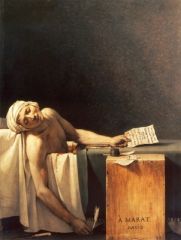
|
David, Death of Marat
This portrait of an assassinated revolutionary became a pendant, a propaganda piece. Marat was ruthless and David displayed his death with great naturalism, attention to detail, sharp lighting, and planarity. He pushes the image much closer to the picture plane, almost to the surface with the knife he was killed with dramatically thrusted into the viewer's space and Marat close behind. Marat's pose is a reference to Christ like pose, and there are personal touches that make the painting seem like David's personal statement such as his signature written on the crate below "To Marat" and the powerful emotions exposed are so unlike any of David's former influences that this intensity of emotion is more similar to the Romantic era that follows. |
|

|
Marie-Louise-Élisabeth Vigée-Lebrun, Self-Portrait with Daughter
The artist is known as a Rococo artist as seen with the use of warm colors and soft contours, but shows her knowledge of Neoclassicism in terms of the musty background and the figures wearing togas and headdress like the ancients. She is also displaying a very Neoclassic idea of childrearing in which the parents are very involved in the raising of their children which is a very new idea. This Enlightenment idea is emphasized by putting the figures against a very plain background. |
|

|
Francisco Goya, Third of May, 1808, oil/canvas. 1814
This Goya has the look of a documentary and tries to put us in the moment. His earlier paintings were very typical Rococo but begins to start "History Painting" which most show somewhat cleaned up and idealized but Goya shows the mayhem and the not glorious part of history, the peasants and the ordinary people involved in the violence. The image is compressed to focus the viewer on the scene specifically and not what may be going on in the background. Goya uses light to draw attention to that figure being executed, he is more celestial and clean compared to the others and seems to be christ like with the stigmata on the hand. The reduced palette, strong light shows an interest in Caravaggio and the incredibly loose brush stroke makes it less staged. The foreshortening of his figures does show he was classically trained as well. |
|
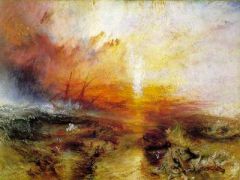
|
J.M.W. Turner, The Slave Ship, oil/canvas. 1840
Turner infused components of the shipwreck through use of color and very loose brush strokes. There is a strong sense of romantic qualities in his use of light, remnants, a sense of nostalgia and infusing color and light not naturalistically but to highlight certain portions. He merges color, texture, and light in a new way and the slave ship was an actual even from the headlines; it was a horrific scandal and he wanted to provoke emotions seeing as how the abolitionist movement had begun. His loose brush stroke makes it very abstract but there is still a clear sense of horizon and the sun is very important to him; he becomes a huge influence for impressionists. |
|

|
Théodore Géricault, Raft of the “Medusa”, oil/canvas. 1818-19
A contemporary history painting, Gericault knew that he would evoke great emotion and provoke a great deal of outrage with this piece. Although it is of a contemporary event, he borrows heavily from classicism. The pyramidal composition is reminiscent of Michelangelo, as well as the composition of the figures and the nudity. He gave these figures of a lower social class a figure. Gericault visited morgues and the mental deranged to get a realistic view of the intensity and capacity to represent the agony and condition of the 150 castaways. |
|
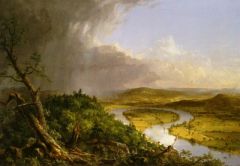
|
Thomas Cole, The Oxbow
The Oxbow is a celebration of the American landscape, a focus on the sublime awesome force of nature that was related to Romanticism. The divine light of America is shown breaking through the clouds, idealizing the American landscape as the Garden of Eden. Along with the ideas of Romanticism, Cole evokes socio-economic issues of the time, his environmentalism and beliefs in Jeffersonian agrarian ideals that aimed to preserve the landscape and avoid the rampant industrialization. |
|

|
Jean-Auguste-Dominique Ingres, Grande Odalisque 1814
One of the earliest examples of Orientalism, Ingres captures a Turkish concubine in Grande Odalisque. There was a fascination with the culture of the muslim world, but also an accompanying sense of superiority. To make his figure more appealing to a Paris audience, he gives her European features, a Raphaelesque face and coiffure. The figure is sensual, and the hasish pipe, incense, fan, and turban authenticate the exotic scene. The painting as a whole projects a soothing sense of cultivated beauty, refinement, and idealization that is Classical. The line of her body is extended in a sensual way, and the chiaroscuro gently swells the body and adds elegance. Ingres treats a Romantic subject in a Neoclassical manner. |
|

|
Eugène Delacroix, Women of Algiers
There is an active and lively use of color, the contours are not emphasized and the palette is punctuated with bright colors, all precursors of the techniques used in Impressionism. The juxtaposition of saturated complementary colors such as the greens and reds brings out the intensity of the colors. The brushstroke is looser and more painterly as well. |
|
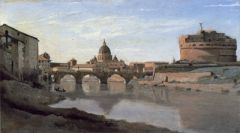
|
Corot, View of Rome
Corot uses loose painterly brushwork and combines quick oil study sketches that capture the intensity of light and shadow, are true to the moment and very naturalistic with an underlying clarity and geometry. He doesn't idealize the landscape like Poussin or Lauren. The qualities of atmosphere come from the creamy colors, use of shadow, and the light brushwork, which are precursors to Impressionism yet he also uses the classical elements of stability and underlying geometry. |
|

|
Thomas Jefferson, University of Virginia, Charlottesville
Jefferson designed the campus based on antiquity in order to evoke the democratic heritage form Greece and Rome as well as the grandeur of these two civilizations, which form the bedrock of Western art and culture. The rows of Palladian villas, the roofed colonnade, the Doric and Ionic orders, were part of a classical revival to create a metaphor for the new republic that expresses both the individualism and the unity that defined the new nation. |

